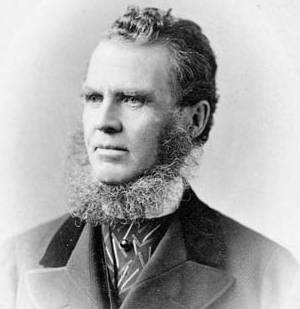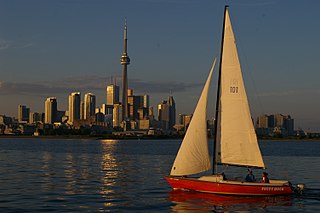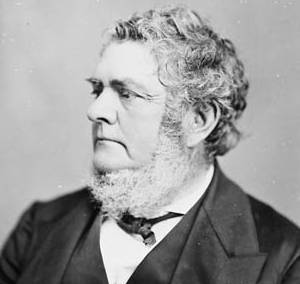This article relies largely or entirely on a single source .(March 2014) |
William Cooper (1761–1840) was an English teacher, businessman and entrepreneur, and political officeholder in Upper Canada; he developed mills and other industries along the Humber River in present-day Ontario and a wharf in York. Prior to 1838, the former name of the Village of Lambton Mills (now within Toronto) was Cooper's Mill, named in his honour in 1806.

The Humber River is a river in Southern Ontario, Canada. It is in the Great Lakes Basin, is a tributary of Lake Ontario and is one of two major rivers on either side of the city of Toronto, the other being the Don River to the east. It was designated a Canadian Heritage River on September 24, 1999.

Ontario is one of the 13 provinces and territories of Canada and is located in east-central Canada. It is Canada's most populous province accounting for 38.3 percent of the country's population, and is the second-largest province in total area. Ontario is fourth-largest jurisdiction in total area when the territories of the Northwest Territories and Nunavut are included. It is home to the nation's capital city, Ottawa, and the nation's most populous city, Toronto, which is also Ontario's provincial capital.

Toronto is the provincial capital of Ontario and the most populous city in Canada, with a population of 2,731,571 in 2016. Current to 2016, the Toronto census metropolitan area (CMA), of which the majority is within the Greater Toronto Area (GTA), held a population of 5,928,040, making it Canada's most populous CMA. Toronto is the anchor of an urban agglomeration, known as the Golden Horseshoe in Southern Ontario, located on the northwestern shore of Lake Ontario. A global city, Toronto is a centre of business, finance, arts, and culture, and is recognized as one of the most multicultural and cosmopolitan cities in the world.
Cooper was born in Bath, England. He started work as a teacher and immigrated at the age of 22 with his wife Ann to Upper Canada in 1793. In this early period after the American War of Independence, it was still largely frontier. They had one son and three daughters. Cooper started what was probably the first school in Toronto in 1798. He petitioned the government for more land to support this occupation and began to buy land on speculation.

Bath is the largest city in the ceremonial county of Somerset, England, known for its Roman-built baths. In 2011, the population was 88,859. Bath is in the valley of the River Avon, 97 miles (156 km) west of London and 11 miles (18 km) south-east of Bristol. The city became a World Heritage site in 1987.

The Province of Upper Canada was a part of British Canada established in 1791 by the Kingdom of Great Britain, to govern the central third of the lands in British North America, formerly part of the Province of Quebec since 1763. Upper Canada included all of modern-day Southern Ontario and all those areas of Northern Ontario in the Pays d'en Haut which had formed part of New France, essentially the watersheds of the Ottawa River or Lakes Huron and Superior, excluding any lands within the watershed of Hudson Bay. The "upper" prefix in the name reflects its geographic position along the Great Lakes, mostly above the headwaters of the Saint Lawrence River, contrasted with Lower Canada to the northeast.
He moved with his family to Yonge Street north of the then Town of York, Upper Canada in 1800. There he was appointed by the provincial government as an auctioneer and the coroner of the Home District, serving in the latter position until 1834. In 1801 he gave up teaching and opened Cooper’s Toronto Coffee House, an inn that became a social centre.

Yonge Street is a major arterial route in the Canadian province of Ontario connecting the shores of Lake Ontario in Toronto to Lake Simcoe, a gateway to the Upper Great Lakes. Until 1999, the Guinness Book of World Records repeated the popular misconception it was 1,896 km (1,178 mi) long, and thus the longest street in the world; this was due to a conflation of Yonge Street with the rest of Ontario's Highway 11. Yonge Street is actually 56 kilometres (35 mi) long. The construction of Yonge Street is designated an Event of National Historic Significance in Canada. Yonge Street was fundamental in the original planning and settlement of western Upper Canada in the 1790s, forming the basis of the concession roads in Ontario today. Once the southernmost leg of Highway 11, linking the capital with northern Ontario, Yonge Street has been referred to as "Main Street Ontario". Today, no section of Yonge Street is a provincial highway.

York was a town and second capital of the district of Upper Canada. It is the predecessor to the old city of Toronto (1834–1998). It was established in 1793 by Lieutenant-Governor John Graves Simcoe as a "temporary" location for the capital of Upper Canada, while he made plans to build a capital near today's London, Ontario. Simcoe renamed the location York after Prince Frederick, Duke of York and Albany, George III's second son. Simcoe gave up his plan to build a capital at London, and York became the permanent capital of Upper Canada on February 1, 1796. That year Simcoe returned to Britain and was temporarily replaced by Peter Russell.
A coroner may conduct or order an inquest into the manner or cause of death, and investigate or confirm the identity of an unknown person who has been found dead within the coroner's jurisdiction.
Cooper and his family moved to the Lambton area in 1806, where he established mills (grist-mill, sawmill, fulling-mill). To encourage development, the government provided machinery for his first mill, on condition that he pay for it or replace it after 18 months. From this Cooper built what is described as the "first milling empire on the Humber." [1] His mills provided basic services for the growing community: grinding its grains, processing lumber for building, and processing woolen cloth.
Cooper founded more businesses in the area: a distillery, cooperage, tannery, blacksmith's shop, store, and tavern. Through his complex of businesses, he owned a total of hundreds of acres on the Humber waterfront, including workers' housing for those who labored in his mills. He got involved in port operations in York, applying for land in 1815 and completing his wharf in 1817, the year the first steamboat operated on Lake Ontario.
Cooper sold his mills in 1827 to his son Thomas, and sold much of his waterfront property a year later. Cooper continued his other business at York as forwarder, commission merchant, and wharfinger until 1830, being closely involved with shipping and the port activities. That year he sold his wharf to Alexander Murray and James Newbigging.
After his wife Ann died, in 1829 Cooper married a second time, to Isabella Watson. They had one son together. Cooper died in 1840.













